Browse Primary Sources
Locate primary sources, including images, objects, media, and texts. Annotations by scholars contextualize sources.

Two Daughters of Akhenaten
The bas-relief, or carved panel, in limestone shows two sisters embracing. They are princesses from the family of Akhenaten, the 18th pharaonic dynasty in ancient Egypt, dated to 1349–1336 BCE. This artistic style belongs to the Amarna period, which is unusual because of the affection and intimate portrayal of the sisters.
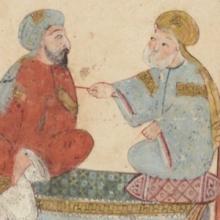
Illustration from The Maqamat of al-Hariri
During the Abassid period and onward, children four or older in villages and urban centers began attending schools (maktabs) attached to mosques to obtain a basic education in religious matters. Students in a maktab sat in a semicircle on the floor around the teacher writing their lessons on a tablet and then repeating it back for correction.
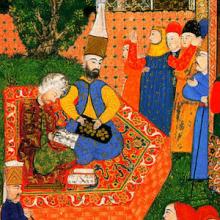
Devshirme System
This Ottoman miniature painting from 1558 shows a group of boys dressed in red, being registered for the devshirme (usually translated as “child levy” or “blood tax”).
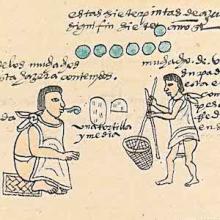
Disciplining Children in the Codex Mendoza
Aztec children were valued creations. Language used in rituals compared infants to precious stones and feathers, flakes of stone, ornaments, or sprouts of plants. The duty of parents and society, however was not to indulge but to socialize the child, so that they would not become "fruitless trees," as an Aztec proverb stated.

Immigrant Crossing Road Sign
Interstate 5 runs from the Mexican/U.S. border crossing at San Ysidro, California, to the Peace Arch Crossing into Canada at Blaine, Washington. This official yellow warning road sign is posted along Interstate 5 near the San Ysidro crossing and north of San Diego. The sign shows a man and a woman running as the woman pulls a girl with pigtails along, her feet barely touching the ground.
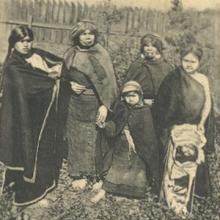
Postcard of Women and Girls with Cradleboard, Temuco, Chile
This postcard, from the early 20th century, shows a group of women and children, most likely belonging to the Mapuche people. The Mapuche occupied a large area in the cone of South America, the territory of the current nations of Chile and Argentina.

Birth Rituals in the Codex Mendoza
The image from the Codex Mendoza (produced ca. 1535-1550) describes the Aztec birth ritual of bathing and naming the child, which, according to accounts from the 16th century, was usually held on the fourth day after birth. It was attended by the parents and kin, who gathered in the house before sunrise to feast and observe the ceremony.
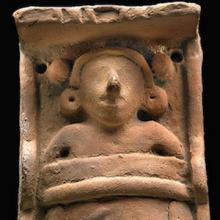
Aztec Cradleboard Figurine and Drawing
The ceramic figurine of an infant in a cradle (also called a cradleboard) was created by the Nahua, or Aztec people of Mexico, between 1350 and 1521 CE. It shows how infants were kept bound in a cradle or carried on a cradleboard, a practice that was common among the indigenous peoples of the Americas. The figurine also shows how the baby would have been bound or swaddled in the cradle.
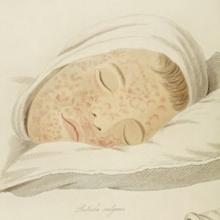
Rubeola Vulgaris - Measles
Robert Willan (1757-1812) was a physician who practiced in London. Like Sydenham he was fascinated by the relation of weather to epidemics and kept strict records on when they occurred over several years. He was particularly interested in the diseases of children and carefully observed rashes and pustules as they developed in stages on the skin.
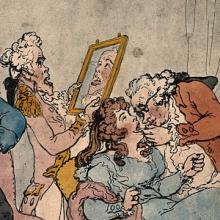
Transplanting Teeth
This print is by Thomas Rowlandson (1756-1827) and is dated 1787. It is a satirical comment upon the real practice of rich gentlemen and ladies of the 18th century paying for teeth to be pulled from poor children and transplanted in their gums. The dentist present is portrayed as a quack. There are even two quacking ducks on the placard advertising his fake credentials.

Age of Menarche in Norway
This graph shows us the average year of menarche, a female's first menstrual cycle (often considered the beginning of puberty), from 1860 to 1980 reported by adult female patients at maternity clinics in Norway. It also includes data from Oslo school girls that follow the same trend downward in age. The downward curve flattens around 1960 between the ages of 13 and 14.
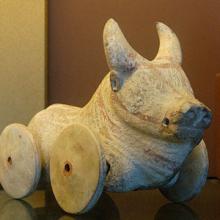
Buffalo on Wheels Toy
This object made from terracotta was most likely a child's pull toy. Approximately 11 centimeters high and 16.5 centimeters long (4.3 x 6.5 inches), it features functional wheels and a hole at the mouth for a string. The buffalo shows traces of stripes in red paint, and has markings that represent its curly forelock. The object is dated to the Archaic Age (ca.
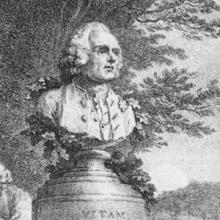
Emile
French philosopher Jean-Jacques Rousseau wrote the philosophical treatise Emile, or On Education in 1762. In it, he imagines a situation in which a young tutor devotes 20 years to raising a single child. In the process, Rousseau lays out many of his fundamental beliefs about the nature of humans and their relationship to society.
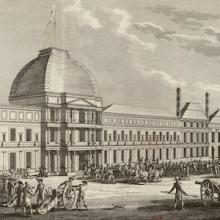
The Days of 31 May and 1-2 June 1793
Even though popular action had unseated the Legislative Assembly and replaced it with the Convention, the elections that followed had not satisfied the radicals of Paris and their artisanal followers. From 31 May to 2 June 1793, these Parisians demonstrated outside the Convention and through intimidation forced the politicians inside to give up the Girondins who were being vilified.
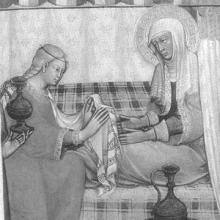
Linen Towel with Indigo Woven Border
Italian noblewomen presented soft, absorbent, linen towels with indigo woven borders to birthing mothers during the 14th century and later. The cultural context of the towels is illustrated in Italian paintings of the period depicting childbirth customs such as presentation and use of the towels.
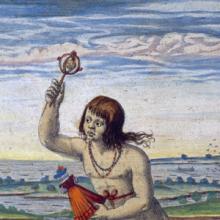
Native American Children and Toys
Theodore de Bry included this colorful engraving in his publication of Hariot's, A Briefe and True Report of the New Found Land of Virginia (1590). It was based on a watercolor by John White (fig. 2) painted five or six years earlier.
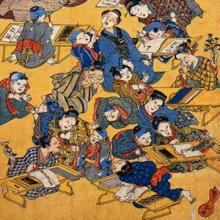
Terakoya vs. Meiji School
Contrary to impression left by document #2, schools for commoners were plentiful prior to the Meiji Restoration in 1868. These schools are usually known by the term terakoya, which literally means "temple school." The first image is of one such terakoya, depicted here in an 18th-century woodblock print.
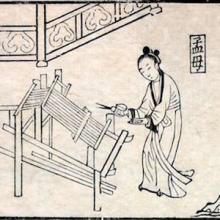
Mencius and his Mother: A Lesson Drawn from Weaving
This illustration depicts a scene from the Traditions of Exemplary Women (Lienü zhuan) of Liu Xiang (ca. 77-6 BCE), one of China's first didactic texts on feminine morality. The text to this story is provided below the illustration. The story recounts the upbringing of Mencius (ca. 371-289 BCE), one of the greatest Confucian philosophers of early China.
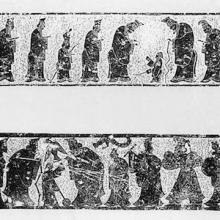
The Boy Prodigy: Xiang Tuo
These two images from the Later Han dynasty (2nd century CE) depict the most famous child in early Chinese literature, Xiang Tuo (pronounced She-Ang Too-o). In both stone carvings, which decorated the outer walls of shrines or funerary monuments, the artists indicated Xiang Tuo's tender age by his relatively smaller size with toys in his hands.
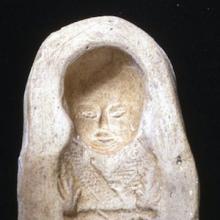
Earthenware Mold of a Swaddled Child
The earthenware mold for casting a figurine of an infant was found in Tangyangu China, and is likely dated to between 960 and 1279 CE, during the Song dynasty. The mold measures 3.2 inches long, and belongs to a collection of molds depicting men, women, and animals.